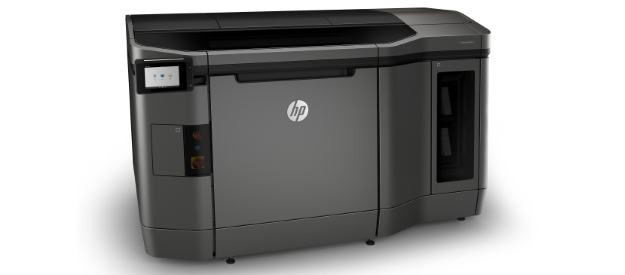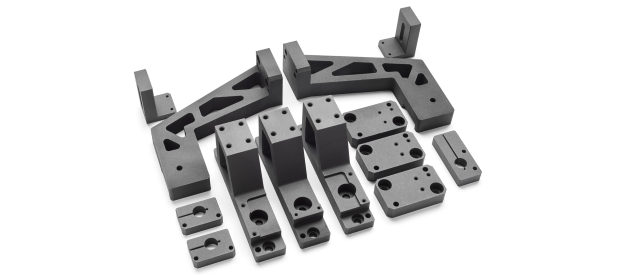
3D Printing in a Gig Economy
By Treena Hein
Additive ManufacturingDesign Fusion’s additive manufacturing brokerage to disrupt the service bureau model while helping justify the ROI for an in-house 3D printer.

According to HP, its 4200 MJF Printer is 10 times faster than other 3D printing technologies (4000 cm³/hr) at roughly half the per-part cost and is capable of layer thicknesses from 0.07 to 0.1mm at a print resolution of 1200 dpi.
Now, however, manufacturers have a third option. For those who would like to take the leap into additive manufacturing but aren’t quite at the volume that justifies the purchase of an industrial 3D printer, Ontario-based additive manufacturing consultant and HP printer dealer, Designfusion, has created a “3D printing brokerage”.
On one level, the brokerage works similar to a service bureau. Parts buyers send their order to Designfusion, which analyzes and processes the 3D geometry but then dispatches the part to the most appropriate manufacturer within the printer brokerage’s “stable.”
At present, this stable encompasses five printers across Canada, spread from BC to Quebec. These manufacturers own and use an HP printer in their own business but are interested in putting their printer to use when they don’t need it.
This leads to the second aim of this ground-breaking brokerage. As anyone in manufacturing knows by now, high-end industrial 3D printers can cost upwards of $500,000, and buying one must therefore make financial sense.
Because the option to join the brokerage stable now exists, manufacturers who couldn’t quite justify the purchase of an HP 3D printer can help off-set the cost by joining the brokerage and gaining extra income from outside print jobs.
“For every company we talk to that’s serious about additive manufacturing and has the volume that makes buying a printer a smart investment, we talk to 15 who are also serious about it but don’t quite have the volume,” explains Trevor Johnstone, Designfusion’s director of additive manufacturing. “Rather than these companies having to wait until they’ve achieved that volume increase, only about 15 or 20 per cent, we can offer them a solution.”
Disrupting the Model
According to Johnstone, the idea for the brokerage didn’t come about in a blinding flash, but rather evolved from a melding of several developments.
“From cold calls on the sales side, and also from our consulting clients, we were hearing ‘we can’t afford a printer,’ and ‘we need this and this printed,’” he explains. “We also had customers who weren’t using their printers to full capacity. We started asking these customers if they wanted to do some outside printing jobs, and if so, we gave out the contact information and both parties took it from there.”
“But there would often be some friction points because everyone is so busy and has so much to handle,” Johnstone adds. “So one day, some of us were all talking about the situation at a meeting, and someone said, ‘You know, we could be the ones to handle it so it all goes smoothly, sort of like a printing broker.’”
In Johnstone’s view, this brokerage will ramp up the adoption of 3D printing significantly. And, not only will it help Designfusion sell more HP 3D printers (it’s been selling them for about two years), but it will increase the need for the firm’s additive manufacturing consulting services, digitizing clients’ physical parts, optimizing designs and so on.

Parts printed on the HP Multi-Jet Fusion line can be produced in six different build material.
Two years ago, LEO Lab purchased an HP MJF 4200 from Designfusion (it was actually the first of HP’s Multi Jet Fusion models to operate in Canada). Because Cohen and his team have always had a focus on innovation, they also created a sister company called IDEATE3D. Similar to a private incubator, the company helps inventors bring their ideas to fruition and to market. IDEATE3D’s clients could use LEO Lab’s printer as required, and the printer could also be available to others.
The teams at LEO Lab and Designfusion had always had a good relationship, notes Cohen. About a year ago, the more they talked, “the more it became clear our interests were pretty closely aligned,” he says. “There are many individuals or organizations that could benefit from an HP MJF but can’t afford it. These are the type of customers IDEATE3D looks for, and Designfusion meets with them all the time. We realized that collaborating would serve Designfusion’s objectives and the objective of IDEATE3D to develop its ‘3D Print Service and Partnership’ business.”
For his part, Johnstone notes that LEO Lab is a perfect example of a new type of entrepreneurial company, that not only looks to bring its specialization to the marketplace but also access a wider market by leveraging new technologies.
Looking Ahead
With the benefits that the printing brokerage model offers parts buyers over what they currently face, Johnstone predicts busy days ahead.
“They don’t have to worry about price, quality or who to buy from – we take care of all that,” he says. “They buy from us. We take the order and match it to the best printer in our stable and see that the order is filled and paid for, at a great price and with the fastest turnaround and highest quality on the market. For those in our printer stable, we look after all the business stuff, all the marketing and sales. They get the digital file, and all they have to do is print and ship the order.”
Currently, Johnstone says most brokerage customers want auto parts printed, with the next-largest demand coming from those who make medical devices and consumer electronics. At present, the service is limited to most Canadian provinces but, in time, Designfusion intends to offer the brokerage service across all of North America. It may also evolve to include other 3D printer technologies beyond HP’s machines.
“A year from now, we see it as inevitable that our brokerage model will outpace the existing 3D print service bureau model in available capacity, price and speed,” says Johnstone. “We want to be Canada’s largest buyer of 3D-printed parts. If our service bureau competitors reduce their price to compete with us, that’s fine. Our main goal is adoption of additive manufacturing and that will come with reduced printing prices and with providing help with design and other aspects that stand in the way of adoption.”
Companies will transition to digital manufacturing when it makes sense financially for them, he adds, and cheaper printing and gaining income from the use of excess printing capacity are significant factors. “We are already in a shared economy,” notes Johnstone, “and from our perspective, a 3D printing brokerage is an idea whose time has come.”
www.designfusion.build/
Treena Hein is an Ottawa-based freelance technology writer.
